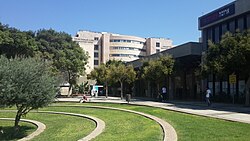|
Tel HaShomer
Tel HaShomer (Hebrew: תֵּל הַשּׁוֹמֵר, lit. Hill of the Guardsman) or Kiryat Krinitzi is a neighborhood in Ramat Gan, Israel. It borders Kiryat Ono in the north, Yehud in the east, and Or Yehuda in the south. A major Israel Defense Forces base and the Sheba Medical Center are located in Tel HaShomer. History Tel Litvinsky (later Tel Hashomer) was a moshava established in 1934 by Moshe and Emil Litvinsky in memory of their father Elhanan Litvinsky. The first inhabitants were Jewish immigrants from Germany and Poland. In 1936, it was noted for its high proportion of academics and doctors.[1] During World War II, most of the village lands were expropriated for the construction of a British military base. The base was of strategic importance because it controlled the Jaffa–Lydda Airport road. It was also used to house Italian prisoners of war. On November 29, 1947, the Palmach stole explosives and 75 rifles from the camp.[2] Towards of the end of the British Mandate for Palestine, Arabs under the command of Hasan Salama began smuggling in arms and personnel disguised as laborers into the camp. The Haganah command saw this as a threat and on April 15, 1948, two companies for the 32nd and 33rd Battalions of the Alexandroni Brigade entered and captured the base. Arab forces counterattacked from al-Khayriyya, Kafr 'Ana, al-'Abbasiyya and Saqiya, but the Jewish forces reinforced and pushed them back to a small salient in the south of the camp, which was captured later in Operation Hametz. The Alexandroni Brigade lost three soldiers, while the Arab losses were estimated at 50.[3] In 1948, the area was renamed Tel HaShomer after HaShomer, an early Ottoman-period Jewish defense organization. LandmarksLocated on the grounds of the Israel Defense Forces base (Camp Yaakov Dori) are:
Medical facilitiesAdjacent to the base are military and civilian hospitals in adjoining complexes known as the Tel HaShomer Hospital. The civilian hospital is Sheba Medical Center. Magen David Adom has its headquarters and main blood bank on site. Notable people
Development plansIn September 2015 it was announced that 11,500 housing units would replace the military complex on the site.[5] References
|
||||||||||||||


